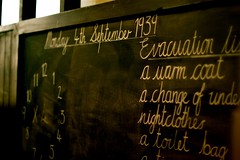Directions:
You are a community organizer working to address some major social problems in your community. Read the scenario below and answer the questions with your group members. For Question #3, use the supplies given to you to create posters with slogans.
Scenario:
You live in a large urban neighborhood in Minneapolis that is strongly stratified by class. The houses on the Southern side of your neighborhood are quite dilapidated, crime is rampant, vital businesses and jobs are scarce, and the neighborhood is in need of revitalization. Most people in this section of the neighborhood make a median income below the poverty line. The Northern side of the neighborhood is more affluent. There are numerous businesses within walking distance, crime has generally remained minimal, and there is a Neighborhood Watch program in place.
Recently, the local news media has exposed an upsurge in crime in the entire neighborhood. A housing crisis is occurring, drug use in the community is extensive and progressively visible, and the school district is in shambles after dropout rates have surged and teacher retention has dwindled. Community members on both the Northern and Southern ends of the neighborhood have increasingly expressed concern about the state of their community. There is a neighborhood organization in place; but all regular members are upper-middle class, and most neighborhood projects and initiatives focus on beautifying the Northern section of town.
Community members from the Southern part of town have recently expressed anger and frustration about their lack of status in community operations. Local government representatives are deliberating on whether or not to install a community policing program in the community or to explore other options. The housing crisis is becoming a wide-scale dilemma, now affecting the middle class and not simply impoverished community members. All families are concerned about the poor resources in their schools and the lack of quality educators. The existing neighborhood group now realizes that they have a crucial role in rallying ALL community members to address the various problems facing the community, and they must come up with some solutions before the upcoming community meeting.
Worksheet: Community Organizing & Social Change
(1) List the social problems in the order in which you will address them. (There are 10 spaces, but if you identify more or less than this, feel free to add or subtract spaces).
1. _____________________________________________
2. _____________________________________________
3. _____________________________________________
4. ____________________________________________
5. ____________________________________________
6. ____________________________________________
7. ____________________________________________
8. ____________________________________________
9. ____________________________________________
10. ___________________________________________
(2) Why did you decide to address social problems in this particular order? Explain your rationale for choosing the first social problem. Why does is this problem top priority? Why is the last concern you listed a lower priority?
______________________________________________________________________________________________________________________________________________________________________________________________________________________________________________________________________________________________________________________________________________________________________________________________________
(3) Use the poster board and markers to create slogans to generate support for your cause. List the slogans you use in the space below.
________________________________________________
________________________________________________
________________________________________________
(4) Why did you choose these slogans? Do they appeal to emotions, humor, or moral shocks?
______________________________________________________________________________________________________________________________________________________________________________________________________________________________________________________________________________________________________________________________________________________________________________________________________
(5) What strategies and tactics will you use to spread your message? Will your tactics center on protest, direct action, education, garnering media attention, etc.— or a combination of these activities? Did your group choose strategies and tactics within or outside of societal norms and institutionalized means? Were tactics legal or illegal?
_____________________________________________________________________________________________________________________________________________________________________________________________________________________________________________________________________________________________________________________________________________________________________________________________________
(6) List your affiliates and opponents. With which organizations, community groups, social movements, and politicians will you align? Which groups will you oppose? Name movement resources (ie: networks, affiliated organizations, money sources, and advocates) from which you will draw.
______________________________________________________________________________________________________________________________________________________________________________________________________________________________________________________________________________________________________________________________________________________________________________________________________
Instructor/Facilitator Directions: (Detach before handing out to students)
Directions: Have students divide into groups of 5 people. Give the groups one worksheet per group and assign the group member roles as follows: one recorder, two reporters, one time-keeper, and one creative director. The creative director will be responsible for making posters with slogans with the poster board and markers provided to each group. Each group will act as community organizers who desire to address the dire conditions of the neighborhood. At the beginning of the class period, you may choose to assign each group different strategies and tactics to help provoke debate or allow group members to choose their own.
Have group members read the vignette and answer the questions on the worksheet. Allow group members 15-20 minutes of class time to organize a plan of action.
Then, in a simulation of a community meeting, act as a facilitator. Allow members of each group to take turns presenting social issues of primary concern, networks, resources, slogans and plans of action. Then, initiate a debate on these issues. Let each group present the social issues of primary importance and their strategies and tactics to address these issues first. Then, ask each group to defend their positions. Have students share slogans and explain who they consider to be allies and who they consider to be opponents. The debate and discussion will end when each group has shared their approach.




